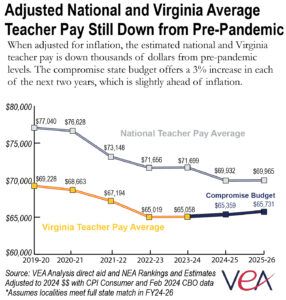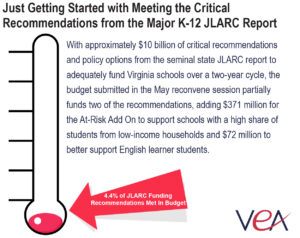VEA Statement on Compromise Budget
May 11, 2024
May 11, 2024
 Richmond, VA – This morning, a preview of the compromise budget negotiated between the General Assembly appropriation committee chairs and Governor Youngkin was released publicly. The baseline for the compromise, hammered out this week behind closed doors, was the conference report budget passed by the General Assembly in March. That proposal included billions of dollars derived from stable revenue sources, such as a modernization of the digital sales tax and state participation in the Regional Greenhouse Gas Initiative (RGGI). In contrast, the budget unveiled today relies on a significantly smaller and more volatile revenue pool, based on a forecast from Virginia’s Department of Taxation. The elimination of the digital sales tax has resulted in a $169 million cut in direct aid to schools compared to the March proposal, disproportionately affecting rural and high-poverty schools. Additionally, continued non-participation in RGGI will result in the loss of billions of dollars in climate and resiliency funding over the coming years, funds that will need to be sourced from the state’s General Funds. As the demand for climate change mitigation grows, this shift will likely have a lasting impact on reducing aid for K-12 education.
Richmond, VA – This morning, a preview of the compromise budget negotiated between the General Assembly appropriation committee chairs and Governor Youngkin was released publicly. The baseline for the compromise, hammered out this week behind closed doors, was the conference report budget passed by the General Assembly in March. That proposal included billions of dollars derived from stable revenue sources, such as a modernization of the digital sales tax and state participation in the Regional Greenhouse Gas Initiative (RGGI). In contrast, the budget unveiled today relies on a significantly smaller and more volatile revenue pool, based on a forecast from Virginia’s Department of Taxation. The elimination of the digital sales tax has resulted in a $169 million cut in direct aid to schools compared to the March proposal, disproportionately affecting rural and high-poverty schools. Additionally, continued non-participation in RGGI will result in the loss of billions of dollars in climate and resiliency funding over the coming years, funds that will need to be sourced from the state’s General Funds. As the demand for climate change mitigation grows, this shift will likely have a lasting impact on reducing aid for K-12 education.
Despite these challenges, the budget retains General Assembly funding for key areas: $371 million for the At-Risk Add-On, $72 million for English learner student support, and $14 million to backfill the promised grocery tax funding from the last budget cycle. This allocation means the General Assembly will fund just over 4% of the recommendations from the seminal 2023 JLARC report, which highlighted Virginia’s lag in K-12 spending compared to other states and the need for targeted support for student groups facing educational barriers.
The budget also included the state’s portion of a 3% pay increase for school employees over each of the next two school years, a gain that slightly keeps ahead of inflation. Given that Virginia has fallen further behind the national teacher pay average according to the most recent national rankings that came out in April, the state will need to offer a 14% increase in the next budget cycle to reach the promised legislative goal from General Assembly leaders of getting to the national teacher pay average by the 2027-28 school year.
“By only meeting 4% of the JLARC funding recommendations and falling further behind the national teacher pay average in this budget, lawmakers must find sustainable ways to increase revenue to meet our critical K-12 funding needs and fulfill their promises,” replied Dr. James Fedderman, president of the Virginia Education Association. He added, “Retreating from RGGI and abandoning modernization of our sales tax in this budget means lawmakers must be even bolder in the coming years to propose significant tax restructuring to address the serious challenges facing our students and staffing shortages across our public schools.”

According to a poll conducted by Virginia Commonwealth University, 66% of Virginians say public schools do not have enough funding to meet their needs.
Learn More